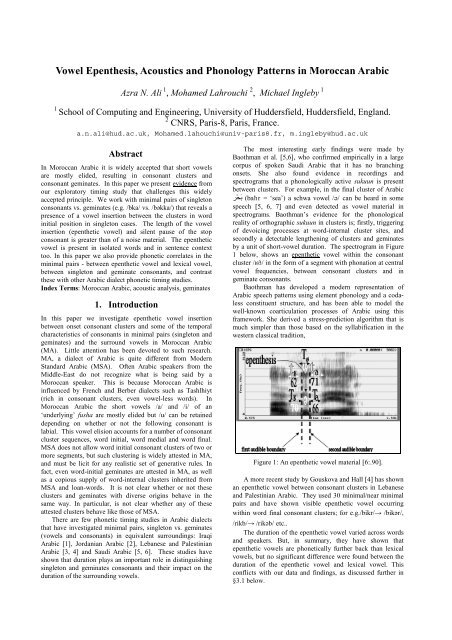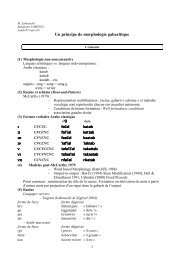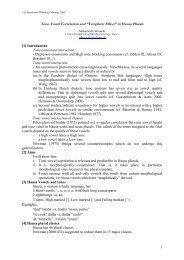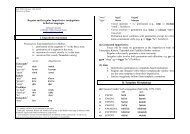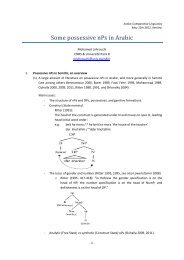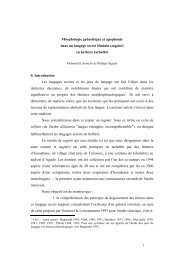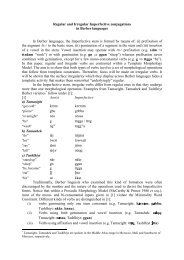Vowel Epenthesis, Acoustics and Phonology Patterns in Moroccan ...
Vowel Epenthesis, Acoustics and Phonology Patterns in Moroccan ...
Vowel Epenthesis, Acoustics and Phonology Patterns in Moroccan ...
Create successful ePaper yourself
Turn your PDF publications into a flip-book with our unique Google optimized e-Paper software.
<strong>Vowel</strong> <strong>Epenthesis</strong>, <strong>Acoustics</strong> <strong>and</strong> <strong>Phonology</strong> <strong>Patterns</strong> <strong>in</strong> <strong>Moroccan</strong> Arabic<br />
Azra N. Ali 1 , Mohamed Lahrouchi 2 , Michael Ingleby 1<br />
1<br />
School of Comput<strong>in</strong>g <strong>and</strong> Eng<strong>in</strong>eer<strong>in</strong>g, University of Huddersfield, Huddersfield, Engl<strong>and</strong>.<br />
2 CNRS, Paris-8, Paris, France.<br />
a.n.ali@hud.ac.uk, Mohamed.lahouchi@univ-paris8.fr, m.<strong>in</strong>gleby@hud.ac.uk<br />
Abstract<br />
In <strong>Moroccan</strong> Arabic it is widely accepted that short vowels<br />
are mostly elided, result<strong>in</strong>g <strong>in</strong> consonant clusters <strong>and</strong><br />
consonant gem<strong>in</strong>ates. In this paper we present evidence from<br />
our exploratory tim<strong>in</strong>g study that challenges this widely<br />
accepted pr<strong>in</strong>ciple. We work with m<strong>in</strong>imal pairs of s<strong>in</strong>gleton<br />
consonants vs. gem<strong>in</strong>ates (e.g. /bka/ vs. /bəkka/) that reveals a<br />
presence of a vowel <strong>in</strong>sertion between the clusters <strong>in</strong> word<br />
<strong>in</strong>itial position <strong>in</strong> s<strong>in</strong>gleton cases. The length of the vowel<br />
<strong>in</strong>sertion (epenthetic vowel) <strong>and</strong> silent pause of the stop<br />
consonant is greater than of a noise material. The epenthetic<br />
vowel is present <strong>in</strong> isolated words <strong>and</strong> <strong>in</strong> sentence context<br />
too. In this paper we also provide phonetic correlates <strong>in</strong> the<br />
m<strong>in</strong>imal pairs - between epenthetic vowel <strong>and</strong> lexical vowel,<br />
between s<strong>in</strong>gleton <strong>and</strong> gem<strong>in</strong>ate consonants, <strong>and</strong> contrast<br />
these with other Arabic dialect phonetic tim<strong>in</strong>g studies.<br />
Index Terms: <strong>Moroccan</strong> Arabic, acoustic analysis, gem<strong>in</strong>ates<br />
1. Introduction<br />
In this paper we <strong>in</strong>vestigate epenthetic vowel <strong>in</strong>sertion<br />
between onset consonant clusters <strong>and</strong> some of the temporal<br />
characteristics of consonants <strong>in</strong> m<strong>in</strong>imal pairs (s<strong>in</strong>gleton <strong>and</strong><br />
gem<strong>in</strong>ates) <strong>and</strong> the surround vowels <strong>in</strong> <strong>Moroccan</strong> Arabic<br />
(MA). Little attention has been devoted to such research.<br />
MA, a dialect of Arabic is quite different from Modern<br />
St<strong>and</strong>ard Arabic (MSA). Often Arabic speakers from the<br />
Middle-East do not recognize what is be<strong>in</strong>g said by a<br />
<strong>Moroccan</strong> speaker. This is because <strong>Moroccan</strong> Arabic is<br />
<strong>in</strong>fluenced by French <strong>and</strong> Berber dialects such as Tashlhiyt<br />
(rich <strong>in</strong> consonant clusters, even vowel-less words). In<br />
<strong>Moroccan</strong> Arabic the short vowels /a/ <strong>and</strong> /i/ of an<br />
‘underly<strong>in</strong>g’ fusha are mostly elided but /u/ can be reta<strong>in</strong>ed<br />
depend<strong>in</strong>g on whether or not the follow<strong>in</strong>g consonant is<br />
labial. This vowel elision accounts for a number of consonant<br />
cluster sequences, word <strong>in</strong>itial, word medial <strong>and</strong> word f<strong>in</strong>al.<br />
MSA does not allow word <strong>in</strong>itial consonant clusters of two or<br />
more segments, but such cluster<strong>in</strong>g is widely attested <strong>in</strong> MA,<br />
<strong>and</strong> must be licit for any realistic set of generative rules. In<br />
fact, even word-<strong>in</strong>itial gem<strong>in</strong>ates are attested <strong>in</strong> MA, as well<br />
as a copious supply of word-<strong>in</strong>ternal clusters <strong>in</strong>herited from<br />
MSA <strong>and</strong> loan-words. It is not clear whether or not these<br />
clusters <strong>and</strong> gem<strong>in</strong>ates with diverse orig<strong>in</strong>s behave <strong>in</strong> the<br />
same way. In particular, is not clear whether any of these<br />
attested clusters behave like those of MSA.<br />
There are few phonetic tim<strong>in</strong>g studies <strong>in</strong> Arabic dialects<br />
that have <strong>in</strong>vestigated m<strong>in</strong>imal pairs, s<strong>in</strong>gleton vs. gem<strong>in</strong>ates<br />
(vowels <strong>and</strong> consonants) <strong>in</strong> equivalent surround<strong>in</strong>gs: Iraqi<br />
Arabic [1], Jordanian Arabic [2], Lebanese <strong>and</strong> Palest<strong>in</strong>ian<br />
Arabic [3, 4] <strong>and</strong> Saudi Arabic [5, 6]. These studies have<br />
shown that duration plays an important role <strong>in</strong> dist<strong>in</strong>guish<strong>in</strong>g<br />
s<strong>in</strong>gleton <strong>and</strong> gem<strong>in</strong>ates consonants <strong>and</strong> their impact on the<br />
duration of the surround<strong>in</strong>g vowels.<br />
The most <strong>in</strong>terest<strong>in</strong>g early f<strong>in</strong>d<strong>in</strong>gs were made by<br />
Baothman et al. [5,6], who confirmed empirically <strong>in</strong> a large<br />
corpus of spoken Saudi Arabic that it has no branch<strong>in</strong>g<br />
onsets. She also found evidence <strong>in</strong> record<strong>in</strong>gs <strong>and</strong><br />
spectrograms that a phonologically active sukuun is present<br />
between clusters. For example, <strong>in</strong> the f<strong>in</strong>al cluster of Arabic<br />
(ba,r = ‘sea’) a schwa vowel /K/ can be heard <strong>in</strong> some بَحْر<br />
speech [5, 6, 7] <strong>and</strong> even detected as vowel material <strong>in</strong><br />
spectrograms. Baothman’s evidence for the phonological<br />
reality of orthographic sukuun <strong>in</strong> clusters is; firstly, trigger<strong>in</strong>g<br />
of devoic<strong>in</strong>g processes at word-<strong>in</strong>ternal cluster sites, <strong>and</strong><br />
secondly a detectable lengthen<strong>in</strong>g of clusters <strong>and</strong> gem<strong>in</strong>ates<br />
by a unit of short-vowel duration. The spectrogram <strong>in</strong> Figure<br />
1 below, shows an epenthetic vowel with<strong>in</strong> the consonant<br />
cluster /7D/ <strong>in</strong> the form of a segment with phonation at central<br />
vowel frequencies, between consonant clusters <strong>and</strong> <strong>in</strong><br />
gem<strong>in</strong>ate consonants.<br />
Baothman has developed a modern representation of<br />
Arabic speech patterns us<strong>in</strong>g element phonology <strong>and</strong> a codaless<br />
constituent structure, <strong>and</strong> has been able to model the<br />
well-known coarticulation processes of Arabic us<strong>in</strong>g this<br />
framework. She derived a stress-prediction algorithm that is<br />
much simpler than those based on the syllabification <strong>in</strong> the<br />
western classical tradition,<br />
Figure 1: An epenthetic vowel material [6:.90].<br />
A more recent study by Gouskova <strong>and</strong> Hall [4] has shown<br />
an epenthetic vowel between consonant clusters <strong>in</strong> Lebanese<br />
<strong>and</strong> Palest<strong>in</strong>ian Arabic. They used 30 m<strong>in</strong>imal/near m<strong>in</strong>imal<br />
pairs <strong>and</strong> have shown visible epenthetic vowel occurr<strong>in</strong>g<br />
with<strong>in</strong> word f<strong>in</strong>al consonant clusters; for e.g./bikr/→ /bikər/,<br />
/rikb/→ /rikəb/ etc..<br />
The duration of the epenthetic vowel varied across words<br />
<strong>and</strong> speakers. But, <strong>in</strong> summary, they have shown that<br />
epenthetic vowels are phonetically further back than lexical<br />
vowels, but no significant difference were found between the<br />
duration of the epenthetic vowel <strong>and</strong> lexical vowel. This<br />
conflicts with our data <strong>and</strong> f<strong>in</strong>d<strong>in</strong>gs, as discussed further <strong>in</strong><br />
§3.1 below.
Little attention has been devoted to <strong>Moroccan</strong> Arabic,<br />
although Boudlal [8] <strong>and</strong> Gafos [9] have conducted tim<strong>in</strong>g<br />
studies. Boudlal focused, however, on syllable length rather<br />
than the detection of vowel <strong>in</strong>sertion <strong>and</strong> s<strong>in</strong>gleton/gem<strong>in</strong>ate<br />
duration contrasts. Gafos used electromagnetic articulography<br />
to exam<strong>in</strong>e <strong>in</strong>ter-consonantal temporal overlap <strong>in</strong> MA clusters<br />
(CC), <strong>in</strong> word <strong>in</strong>itial, word-medial <strong>and</strong> <strong>in</strong> word f<strong>in</strong>al<br />
positions. His f<strong>in</strong>d<strong>in</strong>gs showed there were less stop-stop<br />
consonant overlap <strong>in</strong> word <strong>in</strong>itial positions <strong>and</strong> the overlap<br />
patterns are speaker specific.<br />
Thus, our work is motivated by the studies of [4, 5, 9].<br />
Many of the MA words are derived from MSA <strong>and</strong> therefore,<br />
there is no reason why <strong>in</strong> MA there should be a vowel before<br />
the gem<strong>in</strong>ate consonant but not <strong>in</strong> the s<strong>in</strong>gleton cases. For<br />
example, <strong>in</strong> MSA m<strong>in</strong>imal pair /bakā/ <strong>and</strong> /bakkā/ is<br />
represented <strong>in</strong> MA as /bka/ <strong>and</strong> /bəkka/, no vowel before the<br />
s<strong>in</strong>gleton consonant /k/. It has become widely accepted with<br />
little proof that short vowel are elided <strong>in</strong> the s<strong>in</strong>gleton case<br />
<strong>and</strong> thus result<strong>in</strong>g <strong>in</strong> a branch<strong>in</strong>g onset (consonant cluster).<br />
In our exploratory study, we show that a schwa vowel is<br />
detectable between consonant clusters <strong>in</strong> word <strong>in</strong>itial position<br />
even <strong>in</strong> s<strong>in</strong>gleton cases<br />
2.1. Word set<br />
2. Method<br />
We reviewed 30 frequent m<strong>in</strong>imal pairs (30 s<strong>in</strong>gletons <strong>and</strong> 30<br />
gem<strong>in</strong>ates) consonants <strong>in</strong> MSA. From these we established<br />
which existed <strong>in</strong> MA, a sample shown <strong>in</strong> Table 1. In total<br />
there were 19 s<strong>in</strong>gleton cases which also existed <strong>in</strong> MA, 11 <strong>in</strong><br />
gem<strong>in</strong>ate cases <strong>and</strong> 10 <strong>in</strong> both (s<strong>in</strong>gleton <strong>and</strong> gem<strong>in</strong>ate) which<br />
we list separately <strong>in</strong> Table 2. Audio record<strong>in</strong>gs were done of<br />
only the words listed <strong>in</strong> Table 2. Table 1 <strong>and</strong> 2 omit some<br />
words with their glosses due to page restrictions.<br />
Table 1. Comparison of m<strong>in</strong>imal pairs between MSA <strong>and</strong> MA.<br />
S<strong>in</strong>gleton<br />
Gem<strong>in</strong>ates<br />
MSA MA MSA MA<br />
form form form form<br />
/sam<strong>in</strong>a/ /smən/ /sammana/ none<br />
/ʕat≥asa/ /ʕt≥əs/ /ʕat≥t≥asa/ none<br />
/bakā/ /bka/ /bakkā/ /bəkka/<br />
/fahima/ /fhəm/ /fahhama/ /fəhhəm/<br />
/kataba/ /ktəb/ /kattaba/ none<br />
/xalā/ none /xallā/ /xəlla/<br />
/banā/ /bna/ /bannā/ none<br />
Etc……..<br />
A total of 144 tokens were formed: 18 words x 4 repetitions<br />
(twice <strong>in</strong> isolation <strong>and</strong> twice <strong>in</strong> a phrase context) x 2<br />
participants. The carrier sentence for the target word was<br />
/ʕawKd __________ mKrra x w ra/ (repeat __________ once aga<strong>in</strong>).<br />
The record<strong>in</strong>gs were done <strong>in</strong> a sound booth at the CNRS<br />
centre us<strong>in</strong>g Sony ECM-MS907 microphone. Adobe Audition<br />
1.0 was used <strong>and</strong> the record<strong>in</strong>gs were digitized at a sampl<strong>in</strong>g<br />
rate of 16000 Hz. For each utterance a file conta<strong>in</strong><strong>in</strong>g a<br />
waveform display <strong>and</strong> a spectrogram for each token was<br />
made.<br />
Table 2. Data set - m<strong>in</strong>imal pairs (s<strong>in</strong>gleton <strong>and</strong><br />
gem<strong>in</strong>ates).<br />
S<strong>in</strong>gleton<br />
Gem<strong>in</strong>ates<br />
MSA MA MSA MA<br />
h /fahima/ /fhəm/ /fahhama/ /fəhhəm<br />
k /bakā/ /bka/ /bakkā/ /bəkka/<br />
k /sakat/ /skət/ /sakkat/ /səkkət/<br />
k /sakan/ /skən/ /sakkan/ /səkkən/<br />
l /ʕalam/ /ʕləm/ /ʕallam/ /ʕəlləm/<br />
m /samaʕ/ /sməʕ/ /sammaʕ/ /səməʕ/<br />
ʃ /naʃita/ /nʃətˁ/ /naʃʃata/ /nəʃʃətˁ/<br />
sˁ /wasˁala/ /wsˁəl/ /wasˁsˁala/ /wəsˁsˁəl/<br />
r /barad/ /brəd/ /barrad/ /bərrəd/<br />
2.2. Speakers<br />
In this exploratory study we used two male speakers of<br />
<strong>Moroccan</strong> Arabic.<br />
2.3. Measurements<br />
Praat software [10] was used to produce a waveform display<br />
<strong>and</strong> spectrogram for each token. Firstly, we viewed the<br />
spectrogram of s<strong>in</strong>gleton cases, establish<strong>in</strong>g whether there<br />
was any vowel material <strong>in</strong> the onset consonant cluster for<br />
s<strong>in</strong>gletons, for both speakers. Secondly, we extracted<br />
segmental durational measurements (<strong>in</strong> ms) for:<br />
• epenthetic <strong>and</strong> lexical vowels<br />
• vowels follow<strong>in</strong>g C (s<strong>in</strong>gleton) <strong>and</strong> CC (gem<strong>in</strong>ates)<br />
• consonants - C (s<strong>in</strong>gleton) <strong>and</strong> CC (gem<strong>in</strong>ates)<br />
The acoustic segments were identified from both<br />
waveform <strong>and</strong> spectrograms (wideb<strong>and</strong>) by position<strong>in</strong>g cursor<br />
at time po<strong>in</strong>ts <strong>in</strong> the waveform as well as the segment onset<br />
<strong>and</strong> offset on spectrograms. The total utterance duration was<br />
measured from the onset of the first segment to the closure of<br />
last segment. The criteria used for identify<strong>in</strong>g epenthetic<br />
vowel were via vocalic complex patterns <strong>in</strong> the waveform <strong>and</strong><br />
then checked patterns <strong>in</strong> the accompany<strong>in</strong>g spectrogram, <strong>in</strong><br />
particular the vowel formants.<br />
3. Results<br />
We first analyzed the phonetic duration of isolated words <strong>and</strong><br />
then later analyzed the target word embedded <strong>in</strong> phrase<br />
context. Results detailed <strong>in</strong> §3.1 to §3.2 are for isolated<br />
words.<br />
3.1. <strong>Vowel</strong> <strong>in</strong>sertion<br />
In most cases we found vowel epenthesis similarly to that<br />
reported <strong>in</strong> Saudi Arabic by Baothman [6] <strong>and</strong> <strong>in</strong> Lebanese<br />
<strong>and</strong> Palest<strong>in</strong>ian Arabic by Gouskova & Hall [4]. Spectograms<br />
are provided <strong>in</strong> our forthcom<strong>in</strong>g full paper. We found a<br />
vowel <strong>in</strong> the onset consonant clusters <strong>in</strong> word <strong>in</strong>itial positions<br />
<strong>in</strong> most of the s<strong>in</strong>gleton pairs, for e.g., /bka/ → /bəka/, /nʃətˁ/<br />
→ /nəʃətˁ/ etc. In three of the words <strong>in</strong> the s<strong>in</strong>gleton cases,<br />
however, all s+C clusters e.g. /skən/, it was difficult to f<strong>in</strong>d<br />
any traces of epenthetic vowel material between the<br />
consonant clusters for both speakers. In the correspond<strong>in</strong>g<br />
s+CC gem<strong>in</strong>ates, the vowel duration preced<strong>in</strong>g the gem<strong>in</strong>ate<br />
was considerably reduced <strong>in</strong> comparison to gem<strong>in</strong>ates
follow<strong>in</strong>g consonants other than s. In Table 3 below, we<br />
contrast the durational measurement (ms) of epenthetic vowel<br />
(Və) <strong>and</strong> the preced<strong>in</strong>g lexical vowel <strong>in</strong> gem<strong>in</strong>ates (V1). In<br />
Table 3, means <strong>and</strong> st<strong>and</strong>ard deviation (<strong>in</strong> parentheses) are for<br />
words exclud<strong>in</strong>g the s+C cases s<strong>in</strong>ce no correspond<strong>in</strong>g vowel<br />
<strong>in</strong>sertion was found <strong>in</strong> s<strong>in</strong>gleton cases.<br />
Table 3. Average vowel duration (ms) – s<strong>in</strong>gleton <strong>and</strong><br />
gem<strong>in</strong>ates.<br />
S<strong>in</strong>gleton<br />
CVəCVC<br />
(ms)<br />
Gem<strong>in</strong>ate<br />
CV1CCV(C)<br />
(ms)<br />
/fhəm/ 32.75 /fəhhəm 49.75<br />
/bka/ 30.0 /bəkka/ 55.75<br />
/skət/ - /səkkət/ 39.0<br />
/skən/ - /səkkən/ 40.0<br />
/sməʕ/ - /səmməʕ/ 34.25<br />
/nʃətˁ/ 73.5 /nəʃʃətˁ/ 73.25<br />
/ʕləm/ 86.75 /ʕəlləm/ 65.0<br />
/wsˁəl/ 92.5 /wəsˁsˁəl/ 78.25<br />
/brəd/ 49.5 /bərrəd/ 57.5<br />
Mean<br />
(SD)<br />
60.83<br />
(27.82)<br />
Mean<br />
(SD)<br />
65.85*<br />
(14.15)*<br />
Və – epenthetic vowel * excludes s+C cases<br />
On average the epenthetic vowel varied across words,<br />
rang<strong>in</strong>g from 30ms to 92.5ms. Statistically, exploratory<br />
ANOVA showed no significant difference between the<br />
duration of the epenthetic vowel <strong>in</strong> s<strong>in</strong>gleton <strong>and</strong> the lexical<br />
vowel duration preced<strong>in</strong>g gem<strong>in</strong>ates (F = .626, df = 1, p =<br />
.433). Comparison of the epenthetic vowel was made with<br />
surround<strong>in</strong>g vowels: Table 4 shows the mean duration time<br />
(ms) <strong>and</strong> the st<strong>and</strong>ard deviation <strong>in</strong> parentheses.<br />
Table 4. Mean duration (ms) <strong>and</strong> st<strong>and</strong>ard deviation<br />
(<strong>in</strong> parentheses) for epenthetic vowel <strong>and</strong><br />
surround<strong>in</strong>g vowels.<br />
S<strong>in</strong>gleton – CCV1(C) Gem<strong>in</strong>ate – CV1CCV2C<br />
Və V1 V1 V2<br />
60.83<br />
(27.82)<br />
92.22<br />
(48.61)<br />
65.85*<br />
(14.15)*<br />
89.79<br />
(47.71)<br />
Ve – vowel epenthesis * excludes s+C cases<br />
The duration of the epenthetic vowel on average was 92%<br />
of the duration of the short lexical vowel preced<strong>in</strong>g the<br />
gem<strong>in</strong>ate consonant (gem<strong>in</strong>ate-V1). We refer V1<strong>in</strong> gem<strong>in</strong>ate<br />
as a short vowel as studies have shown that the vowel<br />
preced<strong>in</strong>g the gem<strong>in</strong>ate consonant is shortened to some<br />
degree. For example, below <strong>in</strong> (1) <strong>and</strong> (2) <strong>in</strong> Lebanese Arabic<br />
study by Khattab [3], it is clear that on average the vowel<br />
preced<strong>in</strong>g the gem<strong>in</strong>ate was 66.15% (86ms/130ms x 100%) of<br />
the duration of the full lexical vowel follow<strong>in</strong>g the gem<strong>in</strong>ate<br />
(CC).<br />
vowel pre-s<strong>in</strong>gleton C= 88ms ; pre-gem<strong>in</strong>ate CC= 86ms (1)<br />
vowel post-s<strong>in</strong>gleton C=127ms; post-gem<strong>in</strong>ate CC= 130ms (2)<br />
In our study, the duration of the epenthetic vowel on<br />
average was 92% of the duration of the short lexical vowel<br />
(gem<strong>in</strong>ate-V1) <strong>and</strong> 65.96% of the full lexical vowel (s<strong>in</strong>gleton<br />
V1), established from the data <strong>in</strong> Table 4. But results were<br />
also noted [4] with Lebanese Arabic, the epenthetic vowel on<br />
average was 90% of the full lexical vowel <strong>and</strong> no significant<br />
difference was found between the epenthetic <strong>and</strong> lexical<br />
vowel duration.<br />
We also noted that the epenthetic <strong>and</strong> lexical vowel<br />
duration varies across speakers. Epenthetic vowel ranged<br />
from ~40ms to ~60ms <strong>and</strong> lexical vowel ranged from ~58ms<br />
to ~65ms. Such variation of epenthetic vowel <strong>and</strong> lexical<br />
vowel across speakers was also noted <strong>in</strong> the Lebanese Arabic<br />
study; epenthetic vowel rang<strong>in</strong>g from ~40ms to 120ms <strong>and</strong><br />
lexical vowel rang<strong>in</strong>g from 70ms to 125ms.<br />
3.2. Consonants – s<strong>in</strong>gleton vs. gem<strong>in</strong>ates<br />
The duration for s<strong>in</strong>gle consonant vs. gem<strong>in</strong>ate consonants for<br />
both speakers were pooled as shown <strong>in</strong> Table 5. On average<br />
the duration time for gem<strong>in</strong>ates was twice the duration of<br />
s<strong>in</strong>gletons, with the exception of /rr/ which was almost 4<br />
times greater than the s<strong>in</strong>gleton /r/. Khattab [3] <strong>in</strong> Lebanese<br />
Arabic noted that the s<strong>in</strong>gleton to gem<strong>in</strong>ate ratio for<br />
consonant taps <strong>and</strong> trills (/r/) was 1:7.50.<br />
Table 5. Average consonant duration (ms) – s<strong>in</strong>gleton<br />
<strong>and</strong> gem<strong>in</strong>ates.<br />
S<strong>in</strong>gleton<br />
CCVC<br />
(ms)<br />
Gem<strong>in</strong>ate<br />
CVCCVC<br />
(ms)<br />
Ratio<br />
C to CC<br />
/fhəm/ 72.5 /fəhhəm 143.75 1:1.98<br />
/bka/ 77.75 /bəkka/ 177.75 1:2.28<br />
/skət/ 97 /səkkət/ 204.75 1:2.11<br />
/skən/ 98.5 /səkkən/ 211.25 1:2.14<br />
/sməʕ/ 89.5 /səmməʕ/ 194.5 1:2.17<br />
/nʃətˁ/ 120 /nəʃʃətˁ/ 208.5 1:1.74<br />
/ʕləm/ 74.25 /ʕəlləm/ 177.5 1:2.39<br />
/wsˁəl/ 121 /wəsˁsˁəl/ 183.5 1:1.52<br />
/brəd/ 28 /bərrəd/ 110 1:3.93<br />
Mean 90.89<br />
Mean 170.31 1:1.87<br />
(SD) (28.56)<br />
(SD) (48.36)<br />
Statistically, exploratory ANOVA showed significant<br />
difference between the duration of s<strong>in</strong>gleton <strong>and</strong> gem<strong>in</strong>ates (F<br />
= 79.43, df = 1, p < .0001). The above s<strong>in</strong>gleton/gem<strong>in</strong>ate<br />
ratio f<strong>in</strong>d<strong>in</strong>gs are similar to Saudi Arabic [5, 6] Iraqi Arabic<br />
[1] <strong>and</strong> Lebanese Arabic [3].<br />
3.3. Sentence context<br />
The f<strong>in</strong>d<strong>in</strong>gs from target word embedded <strong>in</strong> the sentence<br />
context shows; firstly, that the epenthetic vowel <strong>in</strong> sentence<br />
context is longer than <strong>in</strong> isolated word cases. Secondly, the<br />
vowel preced<strong>in</strong>g the consonant gem<strong>in</strong>ate <strong>in</strong> s+C cases is<br />
shorter than a full lexical vowel. Thirdly, the duration of the<br />
gem<strong>in</strong>ate consonant is slightly reduced but still rema<strong>in</strong>s twice<br />
the duration of the s<strong>in</strong>gleton consonant. Full data analyses<br />
<strong>and</strong> comparison with isolated words <strong>and</strong> relevant statistical<br />
data are provided <strong>in</strong> our forthcom<strong>in</strong>g full paper.<br />
4. Discussion<br />
Previous studies with Saudi Arabic [5, 6] <strong>and</strong> Lebanese<br />
Arabic [4] found an epenthetic vowel between consonant<br />
clusters. In this exploratory MA study, we have also found<br />
vowel epenthesis between consonant clusters <strong>in</strong> word <strong>in</strong>itial<br />
position (<strong>in</strong> s<strong>in</strong>gleton cases of the m<strong>in</strong>imal pairs). No<br />
significant differences were found <strong>in</strong> the duration between<br />
epenthetic <strong>and</strong> lexical vowel, this confirms the f<strong>in</strong>d<strong>in</strong>gs of [4].<br />
However, the durations of epenthetic schwa were low <strong>in</strong> some<br />
cases, as was also noted by Davidson [11 (work<strong>in</strong>g with<br />
English speakers articulat<strong>in</strong>g Czech consonant clusters) <strong>and</strong><br />
Ridouane [12] (work<strong>in</strong>g with Tashlhiyt consonant clusters).
Dell <strong>and</strong> Elmedlaoui [13] argue that vowel elements (<strong>in</strong><br />
Tashlhiyt) other than the realization of /a/, /i/ <strong>and</strong> /u/ with<strong>in</strong><br />
consonant clusters do not play any role <strong>in</strong> syllable structure.<br />
Several researchers have opposed their idea, <strong>and</strong> state that<br />
epenthetic schwas are part of syllable nucleus. In particular,<br />
Coleman [14] states that epenthetic vowels are phonetic<br />
realizations of syllable nuclei <strong>and</strong> “where no epenthetic vowel<br />
is evident, it can be regarded as hidden by the follow<strong>in</strong>g<br />
consonant, accord<strong>in</strong>g to a gestural overlap model”. This<br />
probably expla<strong>in</strong>s why no epenthetic vowel was evident <strong>in</strong><br />
MA for s+C clusters (<strong>in</strong> s<strong>in</strong>gletons). Although,<br />
phonotactically, s+C is permissible <strong>in</strong> English <strong>and</strong> French <strong>and</strong><br />
both of our participants speak French too, from a syllabic<br />
po<strong>in</strong>t of view, Kaye [15] <strong>and</strong> other researchers would argue<br />
that s+C clusters cannot be treated as branch<strong>in</strong>g onsets,<br />
because word <strong>in</strong>itial /s/+stop clusters violate the Sonority<br />
Sequenc<strong>in</strong>g Pr<strong>in</strong>ciple. But element phonology can treat s+C<br />
clusters as branch<strong>in</strong>g onsets.<br />
Baothman’s [5,6] epenthetic vowels were modeled <strong>in</strong> her<br />
element phonology as phonologically active sukuuns. In our<br />
exploratory study we did not f<strong>in</strong>d signs of phonological<br />
activity of sukuun <strong>in</strong> gem<strong>in</strong>ate consonants, nor vowel<br />
epenthesis <strong>in</strong> s+C clusters. But, there were epenthetic vowels<br />
<strong>in</strong> other word <strong>in</strong>itial consonant clusters, even <strong>in</strong> the cluster<br />
/br/ → /bər/, which is licit <strong>in</strong> English, French <strong>and</strong> even <strong>in</strong><br />
MA. Such f<strong>in</strong>d<strong>in</strong>g was also noted <strong>in</strong> Spanish [16], there was a<br />
vowel epenthesis <strong>in</strong> the cluster /gr/ <strong>in</strong> the word 'grupo'<br />
('group'). The cluster /gr/ is licit <strong>in</strong> Spanish <strong>and</strong> yet <strong>in</strong> the<br />
spectrogram [16:51] the epenthetic vowel was present <strong>and</strong><br />
<strong>in</strong>dependent element which did not constitute part of the<br />
follow<strong>in</strong>g consonant. Also, Coleman [14:735] notes that <strong>in</strong><br />
Tashlhiyt, /r/ is pronounced “with brief vocoids <strong>and</strong><br />
sometimes after the tap, <strong>and</strong> between the <strong>in</strong>dividual closure of<br />
trills”. This supports our current f<strong>in</strong>d<strong>in</strong>gs <strong>in</strong> MA.<br />
Our results with consonant gem<strong>in</strong>ates support other<br />
Arabic dialect studies [1,2,5], that on average the gem<strong>in</strong>ate<br />
consonant is about twice the duration of the s<strong>in</strong>gleton.<br />
Currently, we are extend<strong>in</strong>g our exploratory study with a<br />
much larger corpus of words. More s<strong>in</strong>gleton/gem<strong>in</strong>ate<br />
consonant contrasts <strong>and</strong> consonant gem<strong>in</strong>ates word <strong>in</strong>itially<br />
(e.g. /ddrb/), word-medial (e.g. /bddl/) <strong>and</strong> word f<strong>in</strong>ally (e.g.<br />
/sdd/). Two <strong>and</strong> three consonant clusters word <strong>in</strong>itially (e.g.<br />
/ktab/), word-medial (e.g. /sakt<strong>in</strong>/) <strong>and</strong> word f<strong>in</strong>ally (e.g.<br />
/sakt/), plus, more s+C clusters <strong>and</strong> more participants’<br />
record<strong>in</strong>gs. Thus epenthetic vowels <strong>and</strong> sukuuns may become<br />
more evident which may support for a CV phonology for<br />
<strong>Moroccan</strong> Arabic. Also, with a larger corpus of record<strong>in</strong>g we<br />
will be able to establish phonetic correlates between <strong>in</strong>tended<br />
schwa <strong>and</strong> transitional schwa. In our extended work/paper we<br />
will also show how various phonological theories can account<br />
for epenthetic <strong>and</strong> transitional schwa.<br />
5. Conclusions<br />
The f<strong>in</strong>d<strong>in</strong>gs from our exploratory phonetic tim<strong>in</strong>g study on<br />
MA challenges some of the widely accepted pr<strong>in</strong>ciples, for<br />
e.g. it challenges the st<strong>and</strong>ard hypothesis that short vowels <strong>in</strong><br />
Modern St<strong>and</strong>ard Arabic are elided <strong>in</strong> <strong>Moroccan</strong> Arabic. The<br />
research <strong>in</strong> this paper has raised a number of <strong>in</strong>terest<strong>in</strong>g<br />
questions both from phonetic <strong>and</strong> phonological perspective.<br />
The f<strong>in</strong>d<strong>in</strong>gs <strong>in</strong> her work have motivated the current <strong>and</strong><br />
future work with <strong>Moroccan</strong> Arabic <strong>and</strong> other Arabic dialects.<br />
7. References<br />
[1] Hassan, Z. M. "Gem<strong>in</strong>ation <strong>in</strong> Swedish <strong>and</strong> Arabic with<br />
a Particular Reference to the Preced<strong>in</strong>g <strong>Vowel</strong>: An<br />
Instrumental <strong>and</strong> Comparative approach". Fonetik TMH-<br />
SPSR Proc., 44:81-85, 2002.<br />
[2] Ham, W. "Phonetic <strong>and</strong> Phonological Aspects of<br />
Gem<strong>in</strong>ate Tim<strong>in</strong>g", Routledge, London, 2001.<br />
[3] Khattab, G. "A phonetic Study of Gem<strong>in</strong>ation <strong>in</strong><br />
Lebanese Arabic", ICPhS XVI Proc., 153-158, 2007.<br />
[4] Gouskova, M. <strong>and</strong> Hall, N. "Levant<strong>in</strong>e Arabic<br />
<strong>Epenthesis</strong>: Phonetics, <strong>Phonology</strong> <strong>and</strong> Learn<strong>in</strong>g",<br />
Variation, Gradience <strong>and</strong> Frequency <strong>in</strong> <strong>Phonology</strong><br />
Workshop, Poster, 2007.<br />
[5] Baothman, F. <strong>and</strong> Ingleby, M., "Represent<strong>in</strong>g<br />
Coarticulation Processes <strong>in</strong> Arabic Speech", <strong>in</strong> S.<br />
Boudelaa. (ed.). Perspectives on Arabic L<strong>in</strong>guistics XVI,<br />
John Benjam<strong>in</strong> Publish<strong>in</strong>g, Amsterdam, 95-102, 2002.<br />
[6] Ingleby, M. <strong>and</strong> Baothman, F., " Empty Nuclei <strong>in</strong> Arabic<br />
Speech <strong>Patterns</strong> <strong>and</strong> the Diacritic Sukuun", <strong>in</strong> S.<br />
Boudelaa. (ed.). Perspectives on Arabic L<strong>in</strong>guistics XVI,<br />
John Benjam<strong>in</strong> Publish<strong>in</strong>g, Amsterdam, 83-94, 2002.<br />
[7] Harris, J., "English sound structure", Blackwell, Oxford,<br />
1994.<br />
[8] Boudlal, A. "Constra<strong>in</strong>t Interaction <strong>in</strong> the <strong>Phonology</strong> <strong>and</strong><br />
Morphology of Casablanca <strong>Moroccan</strong> Arabic",<br />
Unpublished doctoral thesis, Université Mohammed V.<br />
[9] Gafos, A., Hoole, P., Roon, D <strong>and</strong> Zeroual, C. "Variation<br />
<strong>in</strong> Overlap <strong>and</strong> Phonological Grammar <strong>in</strong> <strong>Moroccan</strong><br />
Arabic Clusters", In Laboratory <strong>Phonology</strong> X, Mouton<br />
de Gruyter, Berl<strong>in</strong>/New York.<br />
[10] Boersma, P. Ween<strong>in</strong>k, D. 2006. Praat: Do<strong>in</strong>g Phonetics<br />
by Computer (Version 5.0.08) [Computer program].<br />
Retrieved January 1, 2008, from http://www.praat.org/.<br />
[11] Davidson, L. "Phonotactics <strong>and</strong> Articulatory<br />
Coord<strong>in</strong>ation Interact <strong>in</strong> <strong>Phonology</strong>: Evidence from<br />
Nonnative Production", Cognitive Science, Vol. 30,<br />
2006, 834-862.<br />
[12] Ridouane, R. "Voiceless, <strong>Vowel</strong>-less Syllables <strong>in</strong><br />
Tashlhiyt Berber: Phonetic <strong>and</strong> phonological Evidence",<br />
[PDF file] retrieved April 2, 2008 http://lpp.univparis3.fr/equipe/rachid_ridouane/.<br />
[13] Dell, F. <strong>and</strong> Elmedlaoui, M. "Syllables <strong>in</strong> Tashlhiyt<br />
Berber <strong>and</strong> <strong>in</strong> <strong>Moroccan</strong> Arabic", Kluwer, 2002.<br />
[14] Coleman, J. "The nature of Vocoids Associated with<br />
Syllabic Consonants <strong>in</strong> Tashlhiyt Berber", ICPhS XIV<br />
Proc, 735-738, 1999.<br />
[15] Kaye, J., "Do you Believe <strong>in</strong> Magic? The Story of s +C<br />
Sequences". SOAS Work<strong>in</strong>g Papers <strong>in</strong> L<strong>in</strong>guistics, 2:<br />
293-313, 1992.<br />
[16] Ramirez, C.J. "Acoustic <strong>and</strong> Perceptual Characterization<br />
of the Epenthetic <strong>Vowel</strong> between the Clusters Formed by<br />
Consonant + Liquid <strong>in</strong> Spanish", Laboratory Approaches<br />
to Spanish Phonetics <strong>and</strong> <strong>Phonology</strong> Proc, 48-61, 2006.<br />
6. Acknowledgements<br />
We would like to thank Dr F. Baothman for grant<strong>in</strong>g us<br />
permission to use the spectrograms (Figure 1) <strong>in</strong> this paper.


